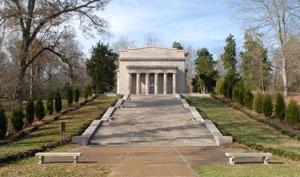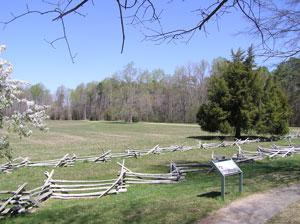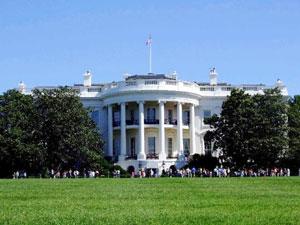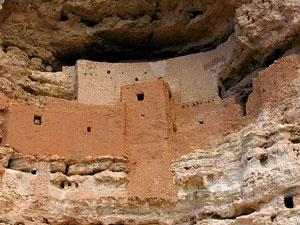The country's first National Historic Site celebrated its 75th anniversary earlier this month, and the occasion offers the opportunity for some fun challenges for NPS trivia buffs. Can you identify the NPS area claiming this historic "first"? How about the location of America's first National Battlefield, or the former national park that's now a national monument?
America's First National Historic Site
Let's begin with the National Park Service (NPS) area which celebrated that recent anniversary. Jonathan Parker is the Chief of Interpretation at the site, and says this area can actually claim two distinctions: the first National Historic Site in the country and the "first expression of the Historic Sites Act of 1935."
That legislation "declared that it is a national policy to preserve for public use historic sites, buildings, and objects of national significance for the inspiration and benefit of the people of the United States." So...where was it first put to use in the National Park Service?
Here's a hint: According to the park website, "When the United States was young, ships from [this location], helped to build the new nation's economy by carrying cargo back and forth from the West to Asia. The historic buildings, wharves, and reconstructed tall ship at this nine-acre National Park tell the stories of the sailors, Revolutionary War privateers, and merchants who brought the riches of the world to America."
Okay, that hint was a bit tricky, since in this case the term "West" doesn't refer to the western United States. Trade with the Orient from our East Coast was a big item in the 19th century; according to the park website, "The largest customs duty bill collected at the Port of Salem was $140,761 when the ship Sumatra returned from Canton in 1831."

Assorted flags fly amidst the rigging of Salem Maritime National Historic Site's tallship, Friendship of Salem, a replica of a 1797 Dutch East Indiaman. Photo by Santos/NPS.
The answer: Salem Maritime National Historic Site in Salem, Massachusetts, was established March 17, 1938. The park will continue its anniversary celebration with a series events through March 2014, so check the park website at intervals to see what's coming up.
Sorting Out the "Historic Firsts"
Before we take a look at some other "historic firsts" in the NPS, a couple of ground rules will be helpful, because this subject can be surprisingly complicated at times.
Quite a few areas in the National Park System achieved some kind of federal designation because of the site's historical significance long before the National Park Service was established in 1916. If those units were at some point part of the National Park System, they're fair game for purposes of this story'but be aware some have undergone one or more name changes over the years. Hey, that's part of the challenge!
Second, many NPS areas are home to both natural and cultural (i.e. "historic") resources, so for purposes of this discussion we'll focus on those for which history seems to have been the primary reason for their original designations.
A "National Park" That Focuses on History
That said, most of the units designated specifically as a national park focus primarily on their natural features'but there is an exception. It was among the first ten national parks established in the U.S., and is famous for some of the oldest structures in the nation. Any guesses?
On June 29, 1906, Mesa Verde National Park was established to protect some 5,000 known archeological sites, including 600 cliff dwellings; they are "some of the most notable and best preserved" examples of such sites in the United States.
The title "national park" has a lot of appeal, and it's not unusual for supporters of an existing national monument or other existing site to campaign for that area to be "upgraded" to a national park. True or not, it's widely perceived that a "national park" designation will draw more visitors. We've covered several of those debates in previous articles on the Traveler, including recent proposals to change the name of Pinnacles National Monument; that revision was finalized in January of this year.
These Former National Parks Now Have New Titles
Such name changes aren't a one-way street, however, and at least two sites that were initially established as a national park now have other titles. One of those areas is sometimes referred to as the "first Lincoln Memorial," but it's located many a mile from the nation's capitol, in rural Kentucky.

The "first Lincoln Memorial" is located in Kentucky. NPS photo.
Abraham Lincoln National Park was established on July 17, 1916, and thus predates the National Park Service itself by just over a month. The national park moniker lasted until 1939, when the area became Abraham Lincoln National Historical Park. An even more descriptive title was later deemed appropriate, and the area is now known as Abraham Lincoln Birthplace National Historical Park.
During its name change from a national park, the second area in question became both a national monument and the only current NPS site to include the words "Historic Shrine" as part of its name.
This site preserves a fort that is best known today for a poem rather than a battle. During the Battle of Baltimore, September 13-14, 1814, Francis Scott Key, a young poet-lawyer, witnessed the bombardment of a nearby fort. Seeing his country's flag still flying over the fort the next morning, he was moved to pen the words that later became our National Anthem. Fort McHenry National Park was established on March 3, 1925, and was renamed Fort McHenry National Monument and Historic Shrine in 1939.

Fort McHenry. NPS Photo
Plenty of Options for Types of Sites
Politicians and park planners have attached plenty of other titles to NPS locations over the years; the System now officially includes 19 different types of areas (plus the inevitable "other" category), including national parks, monuments, seashores and recreation areas.
Of that total, eight are specifically "history-related": National Battlefields, Battlefield Parks, Battlefield Sites, Military Parks, Historical Parks, Historic Sites, International Historic Sites, and Memorials. There is some logic to this myriad of titles, and you'll find a brief explanation in this document on the NPS website.
If you consider yourself to be a pretty serious NPS trivia buff, perhaps you know which of those 19 distinct categories includes the largest number of NPS areas. As of last month, the "official" NPS tally listed 398 units in the National Park System, with the largest number being National Historic Sites (78). Until recently, National Monuments were a close second, with 75, but those numbers changed just this past week with the addition of three new monuments to the NPS fold, making that new total 78 as well. In terms of numbers of types of areas, national parks are in third place, with 59 areas. You'll find the complete official list by category (updated as of March 27, 2013) at this link.
The First "History-Based" National Monument?
National monuments are products of the American Antiquities Act of 1906 , which allows the creation of such sites by presidential proclamation. The claim as the first specifically history-related national monument is actually shared by two sites that were created six months after passage of that bill, on December 8, 1906. Could you use some clues?
One of the sites includes "Inscription Rock, a 200-foot sandstone monolith on which are carved thousands of inscriptions from early travelers. The monument also includes pre-Columbian petroglyphs and the remains of Pueblo Indian dwellings." This area even bucks a trend; it has retained the same name since it was established over a century ago as El Morro National Monument.
Also established on the same date was a site that includes "one of the best preserved cliff dwellings in North America." This 20-room high-rise apartment is nestled into a towering limestone cliff, which is found in Montezuma Castle National Monument in Arizona.
This Battlefield is a National Monument
It's not possible to get very far into a discussion of United States history without encountering a battle of one form or another, so sorting out another another early NPS entry involves yet another rather circuitous path. Any guesses about the battlefield that's still part of the National Park System and has the longest lineage as a federally protected site of a battle?
Two hints: The battle commemorated here was one of the later ones fought on U.S. soil, and although the area's current name includes the word "battlefield," it's not currently designated as a "national battlefield." It is, in fact, now a national monument.
Back on January 29, 1879, the Secretary of War established a national cemetery to protect graves of 7th Cavalry troopers buried after the Battle of the Little Bighorn. In 1886 the site's name was changed to National Cemetery of Custer's Battlefield Reservation and it was redesignated in 1946 as Custer Battlefield National Monument. The current name, Little Bighorn Battlefield National Monument, was adopted in 1991.
Other Ways to Name a Battlefield
There are three current categories of NPS sites that include the name "battlefield," including eleven National Battlefields, four National Battlefield Parks and one National Battlefield Site. Many of these were initially established as National Battlefield Sites, and later redesignated as National Battlefields.
If we treat all three categories as one group, the "first established" in this category has a somber distinction as "the bloodiest one-day battle in American history. According to the park website, "23,000 soldiers were killed, wounded or missing after twelve hours of savage combat on September 17, 1862. The Battle... ended the Confederate Army of Northern Virginia's first invasion into the North and led to Abraham Lincoln's issuance of the preliminary Emancipation Proclamation."
Established on August 30, 1890, as Antietam National Battlefield Site, the Maryland park was redesignated Antietam National Battlefield in 1978.

Burnside Bridge is a key landmark at Antietam National Battlefield. NPS photo.
Purists who'd like to search out the first area to be specifically dubbed a "National Battlefield" would have a tie of sorts, since two sites were awarded that title in 1961.
The battle at Fort Necessity in the summer of 1754 was the opening action of the French and Indian War. Fort Necessity National Battlefield Site dates to March 1931, and was redesignated a national battlefield on August 10, 1961.
On that same date, Tupelo National Battlefield Site was redesignated as a national battlefield, but a visit there is a quick one. This NPS area consists of a one-acre monument located on Main Street in Tupelo, Mississippi, and is administered by the Natchez Trace Parkway. There are no visitor facilities at this national battlefield.
National Military Parks and Historical Parks Include Other Famous Battle Sites
The scenes of several important battles, including Gettysburg and Vicksburg, are protected in nine national military parks. The first to officially receive that title is located in two adjoining states and includes the sites of two separate battles fought two months apart in 1863 for control an area known as the "Gateway to the Deep South." The Confederates were victorious in the first round while Union troops won the upper hand nearby two months later. After the fighting, a Confederate soldier ominously wrote, "This...is the death-knell of the Confederacy." Chickamauga and Chattanooga National Military Park in Georgia and Tennessee was established in August 1890.
Still other famous battles are commemorated in national historical parks, although those areas also commemorate famous people, places and events other than battles.

Surrender Field in Colonial National Historical Park marks the decisive British defeat at Yorktown in 1781. NPS photo.
Perhaps it's fitting that the first area to receive this designation includes both Jamestown, the first permanent English settlement in North America and Yorktown, the site of the final significant battle of the American Revolution. Originally created as Colonial National Monument on July 3, 1930, the area became Colonial National Historical Park on June 5, 1936.
Last on our list is the only International Historic Site in the NPS. As a counterpart of sorts to the English influence in Yorktown, this site marks an attempted French settlement in 1604 which led to the founding of New France. Located on the U.S.-Canadian border in Maine, Saint Croix Island International Historic Site was first established as a national monument in 1949 and received its present name in 1984. Visitor facilities are open from late May to early October.
The First History-Based Site by Any Name?
So, let's go back to the two ground rules established at the beginning of this story, and ask a final question. Among all the sites that have been part of the National Park System, which was the first to achieve some kind of federal designation because of its historical significance? Is it one of the above, or is it to be found somewhere else?
I'm the first to admit the definitive answer to that question is a bit murky and subject to friendly debate, so feel free to offer your own opinions. For my primary reference to this article, I used the National Parks Index 2009-2011 (the latest version of that NPS publication.)
I'd suggest a strong contender for the overall title of our first national historical "icon" should be the Washington Monument, which was authorized in January 1848 and dedicated February 21, 1885.
Some might even make a case for the home of the Washington Monument, the National Mall'the "landscaped park extending from the Capitol to the Washington Monument." The Mall was authorized by Congress on July 16, 1790, although I would ask when it first achieved "historical significance." The National Mall was transferred to NPS management in 1933.
What about Ford's Theater, site of Lincoln's assassination? Although the federal government purchased the building in 1866, it was then converted into office space and used as such until a partial structural collapse occurred in 1893. It wasn't until after it was turned over to the Department of the Interior in the 1930s that it was opened to the public as the "Lincoln Museum."
Still others could offer a good argument for one of the most famous buildings in the country, and one which many people don't immediately associate with the NPS. The cornerstone for the White House was laid on October 13, 1792, and the structure has been the residence and office of U.S. presidents since November 1800. Its primary purpose was clearly for those functions, not as an "historic site," but there's no doubt this old house has seen plenty of history!

The White House is part of the NPS area called President's Park.
Although operation of the White House and its furnishings is a complicated arrangement involving agencies such as the Secret Service, White House Police and Smithsonian Institution, the overall administration of the house and grounds was transferred to the National Park Service in 1933 and clarified by Public Law 87-286 on September 22, 1961. The White House is one of the eleven sites in the "other" category of NPS designations, and is now part of the NPS area known as President's Park.
History can be very interesting, but sorting out which came first'the monument or the battlefield'isn't always easy. Ultimately, the order of their addition to the National Park System isn't really important, if we'll just appreciate and protect them for many more years to come.




 Support Essential Coverage of Essential Places
Support Essential Coverage of Essential Places







Comments
Fascinating. Thanks, Jim.
Retired NPS employee Dennis Burnett (no relation to the author of this story) gets the Eagle Eye award for being the first to identify a questionable "historic first" identified above. Dennis sent the following comment to me via e-mail:
"When I worked at the arch in St. Louis in the middle 1980's, they touted the fact that they were the first National Historic Site, established on December 21, 1935, by Executive Order; Jefferson National Expansion Memorial National Historic Site. Some web sites refer to it as a National Memorial, but I can find nothing that says it was not always a NHS. Am I remembering wrong?"
That's a great example of the often complicated history of various NPS designations, since the information Dennis provided was not obvious from the park's entry in the National Parks Index 2009-2011. So, I dug a bit deeper and found a copy of the administrative history for Jefferson National Expansion Memorial (JNEM).
Here's an excerpt from that history: "On December 21, 1935, President Roosevelt signed Executive Order 7253 permitting the secretary of the interior to acquire and develop the Jefferson National Expansion Memorial. This became the country's first national historic site designated under the Historic Sites Act."
That claim of a "first" is of course an interpretation offered by the writer of the park's history, but there's merit to the idea.
A reading of the actual Executive Order confirmed it was for the purpose of " Allocation Of Funds To The Secretary Of The Interior For The Acquisition And Development Of A Historic Site To Be Known As The Jefferson National Expansion Memorial."
So, we could have view this one either way. If the term "a historic site" is used in a generic sense, it appears that JNEM could have been the first "historic site" designated under the Historic Sites Act. However, in a more specific sense, JNEM was not the first to include the actual words "National Historic Site" as part of its official name.
Fun, eh? Any other thoughts?
Thanks, Jim, for a fun article with lots of great trivia.
I'm amused that in your link the NPS lists 319 units, but it claims 401 units here, and has attendance data for 361 units.
Thanks for the comment, Bob. I think the "319" must have been a typo on my part, but these numbers are a moving target :-) The totals did change slightly since the story was first written, thanks to the recent addition of the three national monuments, so I've updated the link in the story to reference the list with the latest total of 401 units.
Don't back off so quickly, Jim. There are only 367 parks in the 2012 data here :
https://irma.nps.gov/Stats/SSRSReports/System%20Wide%20Reports/5%20Year%...
Add the 3 new NMs, and I only get 370.
What's going on? Well, Bob Janiskee had a nice article in the Traveler.
/2008/09/are-there-really-391-units-national-park-system-you-won-t-think-so-after-you-read
How many units in the system? Well, the official number of 401 is certainly wrong. Beyond that . . . ?
Bob Pahre - Thanks for pointing out Bob Janiskee's great previous story on the challenges in nailing down the exact number of areas in the National Park System. When my curiosity was aroused by the question of the "first" NPS area in various categories, I remembered Bob's story and decided I would try to stay away from that "total numbers" briar patch, and focus on the "which came first" piece of the puzzle. I'm not sure now that my topic is any less thorny :-)